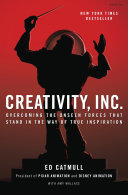

In 'Creativity, Inc.', Ed Catmull emphasizes the importance of viewing failure not as a setback but as an integral part of the creative process. He argues that many of the most innovative ideas emerge from the ashes of failed attempts. This perspective encourages teams to take risks and experiment without the fear of repercussions. Catmull shares anecdotes from Pixar’s history, illustrating how initial failures in projects led to breakthroughs in storytelling and animation. For instance, the early struggles with movies like 'Toy Story' and 'Finding Nemo' were pivotal in shaping the studio's approach to creativity. By fostering an environment where failure is accepted, organizations can cultivate a culture of innovation, where team members feel safe to share unconventional ideas and challenge the status quo. This idea also highlights the importance of resilience in creative endeavors; learning from mistakes is crucial for growth and development.
Continue readingCatmull stresses that trust is the foundation of a creative workplace. He believes that when employees feel trusted and valued, they are more likely to contribute their best ideas. A trusting environment encourages open communication, collaboration, and honest feedback, which are essential for creativity to flourish. In the book, Catmull recounts how Pixar established a culture of candidness where everyone, regardless of their position, could voice their opinions on projects. This approach not only led to better films but also enhanced team morale. The emphasis on trust means that leaders must be transparent and approachable, allowing for a sense of psychological safety among their teams. When individuals know their contributions are appreciated and that their voices matter, they are more inclined to take initiative and innovate.
Continue readingA clear and inspiring vision is crucial for guiding creative endeavors. Catmull discusses how Pixar's vision was pivotal in aligning the team’s efforts and maintaining focus on their goals. This vision is not just about profitability or success; it encompasses a commitment to storytelling, artistry, and pushing the boundaries of animation. By articulating a compelling vision, leaders can motivate their teams and foster a sense of purpose. Catmull also notes that this vision should be revisited and refined over time, as the creative landscape is constantly evolving. A strong vision helps to navigate challenges and maintain momentum, ensuring that the organization remains true to its core values while adapting to new opportunities.
Continue readingCollaboration is at the heart of creativity, and Catmull emphasizes the value of diverse perspectives in the creative process. By bringing together individuals with different backgrounds, experiences, and skill sets, organizations can generate a wider array of ideas and solutions. Catmull illustrates this point through Pixar's collaborative projects, where teams are encouraged to work together across disciplines. He highlights that the best ideas often come from the intersection of different viewpoints. This idea encourages leaders to create cross-functional teams and facilitate interactions among employees to spark innovation. Additionally, fostering an inclusive environment where everyone feels their contributions are valued can lead to richer creative outcomes.
Continue readingLeadership plays a pivotal role in nurturing creativity within organizations. Catmull outlines the responsibilities of leaders in creating a conducive environment for innovation. This includes providing resources, removing obstacles, and empowering team members. He stresses that leaders should be facilitators rather than dictators, allowing creativity to emerge organically. Catmull shares his own experiences as a leader at Pixar, illustrating how he balanced guidance with autonomy. Effective leaders also need to be adaptable, willing to change their approach based on the evolving needs of their teams. By cultivating a supportive leadership style, organizations can unlock the creative potential of their employees.
Continue readingFeedback is a crucial component of the creative process, and Catmull advocates for a culture of constructive criticism. He emphasizes that feedback should be seen as a tool for improvement rather than a personal attack. At Pixar, the practice of 'braintrust' meetings exemplifies this idea, where filmmakers present their work to a group of peers who provide honest, candid feedback. This process helps to refine ideas and elevate the final product. Catmull argues that effective feedback should be specific, actionable, and focused on the work rather than the individual. By fostering an environment where feedback is welcomed and valued, organizations can accelerate creative development and enhance the quality of their output.
Continue readingSustaining creativity over time is a challenge for many organizations. Catmull discusses strategies for maintaining a vibrant creative culture, including continuous learning, adaptation, and the willingness to evolve. He stresses that creativity is not a one-time achievement but a continuous journey that requires ongoing effort and commitment. Leaders must be proactive in identifying potential stagnation and finding ways to reinvigorate their teams. This could involve professional development opportunities, exploring new technologies, or encouraging experimentation with new ideas. Catmull also highlights the importance of celebrating successes and learning from failures as part of this journey. By prioritizing sustainability in creativity, organizations can remain relevant and innovative in a rapidly changing landscape.
Continue reading